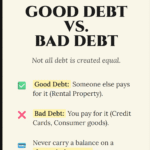Every year on January 1st, millions of people set goals. “I want to get in shape.” “I want to save more money.” “I want to learn a new language.”
By February 1st, 80% of those people have quit.
Why? Are they lazy? Are they incapable? No. They failed because they didn’t set goals; they set wishes.
A wish is a vague desire: “I want to be rich.” A goal is a concrete target: “I will have a net worth of $100,000 by December 31st.”
If your goals are vague, your results will be vague. To bridge the gap between where you are and where you want to be, you need a framework that forces clarity and accountability. You need S.M.A.R.T. Goals.
In this final guide of our series, we will dissect the acronym that is used by Fortune 500 CEOs and elite athletes to turn the impossible into the inevitable.

Part 1: What are SMART Goals?
Shutterstock
Explore
S.M.A.R.T. is an acronym that acts as a checklist for your ambition. If a goal does not meet all five criteria, it is not ready to be acted upon.
- S = Specific
- M = Measurable
- A = Achievable
- R = Relevant
- T = Time-Bound
Let’s break down exactly how to apply each letter to your life.
Part 2: S – Specific ( The “Sniper” Rule)
Most people use a shotgun approach to life. They spray effort in a general direction and hope to hit something. You need to be a sniper.
The Question: Is this goal clear enough that a stranger could understand exactly what needs to be done?
- Bad Goal:“I want to save money.”
- Why it fails: How much? For what? Is $1 saved a success? Is saving $100 a success?
- Better Goal:“I want to save for a house.”
- Why it fails: Still too broad.
- SMART Goal: “I want to save $20,000 for a down payment on a house in the suburbs.”
The 5 Ws of Specificity:
- Who: Is involved? (Just me, or my partner too?)
- What: Do I want to accomplish?
- Where: Is it happening? (At the gym? At the bank?)
- When: (See Time-Bound).
- Why: (See Relevant).
Part 3: M – Measurable (The Scoreboard)
Peter Drucker, the father of management, famously said: “What gets measured gets managed.”
If you cannot measure it, you cannot improve it. You need a binary outcome. At the end of the timeline, you should be able to answer “Yes” or “No”—did I hit the number?
The Question: How will I know when it is accomplished?
- Bad Goal:“I want to lose weight.”
- Why it fails: If you lose 0.1 lbs, technically you succeeded. But you won’t feel successful.
- SMART Goal: “I want to lose 15 pounds.”
The “Leading” vs. “Lagging” Measures:
- Lagging Measure: The final result (Losing 15 lbs). You can’t control this directly today.
- Leading Measure: The daily inputs (Eating 1,800 calories, walking 10,000 steps).
- Strategy: Make your goal measurable by tracking the Leading Measures. “I will track my calories for 30 days straight.”
Part 4: A – Achievable (The Reality Check)
This is the most delicate balance. A goal should stretch you, but not snap you. If a goal is too easy, you get bored. If a goal is impossible, you give up. You need to find the “Sweet Spot” of difficulty.
The Question: Do I have the resources, time, and skills to do this?
- Bad Goal: “I will become a billionaire next year.” (Unless you are already a multimillionaire, this is delusional).
- Bad Goal: “I will never eat sugar again.” (Unrealistic restriction leads to bingeing).
- SMART Goal: “I will increase my income by 15% this year by getting a certification and asking for a raise.”
The “Evidence” Test: Has anyone else in your situation achieved this? If yes, it is achievable. If no, you are trying to break a world record—which is fine, but recognize the difficulty.
Part 5: R – Relevant (The “Why”)
This is the emotional anchor. You can set a Specific, Measurable, Achievable goal that you hate. If the goal doesn’t matter to you, you will quit the moment it gets hard.
The Question: Does this align with my long-term values and life vision?
- Scenario: You think you should learn to code because everyone says “coding is the future.” But you hate computers and love gardening.
- Bad Goal:“Learn Python by December.”
- Why it fails: It’s not relevant to your happiness.
- SMART Goal: “Complete a Master Gardener course by Spring to start a landscaping side hustle.”
The “So What?” Test: Ask yourself “Why?” three times.
- I want to save $10k. Why?
- To have an emergency fund. Why?
- So I don’t feel anxious every time the car makes a noise.
- Bingo. The goal isn’t money; the goal is Peace of Mind. That is relevant.
Part 6: T – Time-Bound (The Deadline)
A goal without a deadline is just a dream. Deadlines create urgency. They trigger Parkinson’s Law (Work expands to fill the time available).
The Question: When is the absolute finish line?
- Bad Goal:“I will write a book someday.”
- Result: You will die with the book inside you.
- SMART Goal: “I will write the first draft of my book (50,000 words) by November 30th.”
Micro-Deadlines: A year-long deadline is too far away. Break it down.
- Annual Goal: Save $12,000 by Dec 31st.
- Monthly Goal: Save $1,000 by the 30th of this month.
- Weekly Goal: Transfer $250 this Friday.
Part 7: Examples of Transformation
Let’s take vague resolutions and turn them into SMART goals.
Category: Finance
- Vague: “I want to invest.”
- SMART: “I will open a Roth IRA at Vanguard and contribute $500 per month automatically on the 1st of every month for the next 12 months.”
Category: Career
- Vague: “I want a new job.”
- SMART: “I will apply to 5 jobs per week in the Tech industry and reach out to 2 recruiters on LinkedIn every Friday until I secure a new offer.”
Category: Health
- Vague: “I want to run.”
- SMART: “I will complete the ‘Couch to 5K’ training program (running 3x a week) and finish the local City Marathon on October 15th in under 30 minutes.”
Part 8: The Hidden Pitfall (Outcome vs. Process)
Even with SMART goals, you can fail if you focus too much on the outcome (which you can’t control) and not enough on the process (which you can control).
Outcome Goal: “I will get 10,000 followers on Instagram.”
- Problem: You can’t force people to follow you. If the algorithm changes, you fail.
Process Goal: “I will post 3 high-quality Reels per week and engage with 10 accounts daily for 6 months.”
- Benefit: You control this 100%. If you do this, the followers will likely come, but your success is defined by your action, not the result.
The Strategy: Set the SMART Outcome goal to set the direction, but focus your daily energy on the SMART Process goal.
Part 9: Review and Pivot
A SMART goal is written in pen, but the plan is written in pencil. Life happens. You get sick. You lose a job. You have a baby.
The Quarterly Review: Every 90 days, look at your goals.
- Are they still relevant? (Maybe you don’t want to buy that house anymore).
- Are they still achievable? (Maybe you lost income and need to lower the savings target).
- Are you on track?
Changing a goal isn’t failure; it’s navigation. If the road is blocked, find a new route. Just don’t stop driving.
Conclusion
You now have the complete toolkit.
You have the Budget strategies (50/30/20). You have the Mindset hacks (No-Spend Weekend, Impulse Control). You have the Growth engines (Investing, Career). And now, you have the Framework (SMART Goals) to tie it all together.
Knowledge without action is just entertainment. You have read 15 guides. You know more about personal finance and self-management than 95% of the population.
The only thing left to do is to start. Pick one goal. Make it SMART. Write it down. And go win your year.



















